A groundbreaking study led by Washington State University researchers reveals that origin of bees dates back more than 120 million years to the ancient supercontinent Gondwana, surpassing previous estimates. The research suggests bees emerged earlier, diversified rapidly, and spread widely, challenging prior assumptions.
The study, titled "The Evolutionary History of Bees in Time and Space" published in the journal Current Biology, sheds light on the spatial origin of bees, a long-standing puzzle in the scientific community.

Bees' Origin Traced Back 120 Million Years Ago to Ancient Supercontinent Gondwana, Rewriting Evolutionary History
Broadest Genomic Study Reveals Evolution of Bees
Collaborating with teams across the globe, Dr. Silas Bossert and Dr. Eduardo Almeida co-led the comprehensive study involving over 200 bee species, comparing their genes with traits from 185 bee fossils and extinct species. Phys.org reported that the groundbreaking study established an evolutionary history of bees and unveiled genealogical models, providing insights into historical bee distribution.
In a news release, Elizabeth Murray, an assistant professor of entomology at WSU, expressed that this study marks the inaugural instance of having comprehensive genome-scale data for all seven bee families.
Using a vast genomic dataset, including hundreds to thousands of genes, the team ensured accurate inferences regarding bee relationships. This remarkable study marked the first time that genome-scale data covered all seven bee families, an essential breakthrough for bee research.
The findings traced the origins of bees back to western Gondwana during the early Cretaceous period, revealing that bees emerged from wasps, transitioning into nectar and pollen collectors from predators. Remarkably, statistical evidence now confirms that bees originated in Gondwana, making them native to the southern hemisphere.
As continents formed, bees migrated northward, thriving alongside flowering plants in a mutualistic relationship. The expansion continued as they colonized India and Australia. Remarkably, all major bee families diverged prior to the Tertiary period, approximately 65 million years ago, coinciding with the extinction of dinosaurs.
READ ALSO: Bees Declared To Be The Most Important Living Being On Earth
Western Hemisphere's Rich Flora Influenced By Bees
Beyond revealing the origin of bees, this bee-centric study also sheds light on their evolutionary impact on plant life. According to Sci-News, the rich flora in tropical regions of the western hemisphere is thought to be closely linked to their longstanding association with bees.
Notably, one-quarter of all flowering plants belong to the diverse rose family, which plays a significant role as host plants for bees in both tropical and temperate regions.
The authors' future endeavors involve extending their research to encompass more species of bees. Unraveling the genetics and history of these species is crucial in understanding the co-evolution of bees and flowering plants. Such insights could aid in maintaining healthy pollinator populations, becoming increasingly important as conservation efforts for bees gain traction.
Dr. Murray emphasized the significance of this work, describing it as a stepping stone for further investigations into the historical and ecological aspects of bees. As people increasingly focus on bee conservation, this study opens doors to better comprehend how bees spread and adapted to their current ecological niches.
RELATED ARTICLE: Bees, Pollinators, Pollination Under Threat Due to Environmental Pressures: Analysis Cites Agrochemicals Including Pesticides Among the Causes
Check out more news and information on Bees in Science Times.










!['Cosmic Glitch' in Einstein's Theory of General Relativity Could Be Explained in This New Scientific Tweak [Study]](https://1721181113.rsc.cdn77.org/data/thumbs/full/53435/258/146/50/40/cosmic-glitch-in-einsteins-theory-of-general-relativity-could-be-explained-in-this-new-scientific-tweak-study.jpeg)



